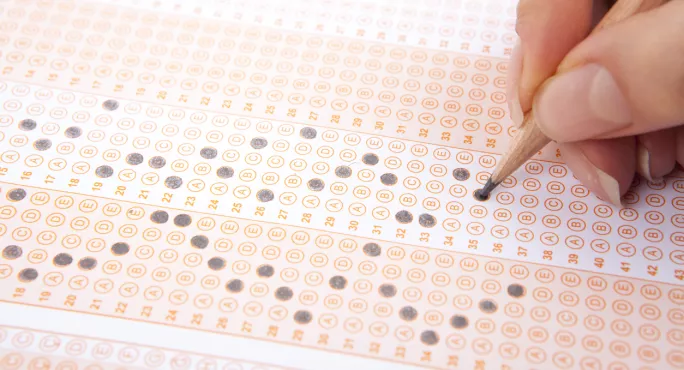- Home
- GCSEs: the science behind multiple-choice questions
GCSEs: the science behind multiple-choice questions

A quick question: what chance is there that a person will guess the correct answer to a multiple-choice question?
a) 0%
b) 25%
c) 50%
d) 100%
The answer depends on how well the question has been written.
Multiple-choice questions are something we all come across in our everyday lives and probably more often than we realise.
Quick read: GCSE: Why we should let all children study literature
Quick listen: GCSEs: what has been the impact of the shift to linear exams?
Want to know more? Treating my GCSE class like undergraduates boosted results
Most of these will ask our opinion on something or measure how often we do something, not test us under exam conditions.
What are multiple-choice questions?
A multiple-choice question is defined as a question composed of two parts: a stem that identifies the question or problem, and a set of alternatives or possible answers that contain one correct answer to the question and a number of other options that are plausible but incorrect answers to the question.
Multiple-choice questions can be a very good way to test students and provide a useful level of flexibility to assessment writers.
They allow an exam to cover more of the specification in less time because each question is quick to answer. They’re very reliable to mark as there’s no subjectivity.
And they’re flexible, allowing assessment writers to measure lower-order processes such as knowledge recall and comprehension - and higher-order processes such as application, interpretation, synthesis and analysis.
They’re also less predictable as they can sample a wide range of content from across the specification, which encourages students to learn the whole specification and gain a broader appreciation of the subject rather than just focusing on material considered likely to appear in a test.
How do multiple-choice questions work?
Multiple-choice questions used in examinations are carefully designed to eliminate some of the guessing by using something called distractors.
That’s the technical term, but a distractor isn’t used to trick students or catch them off-guard - instead its purpose is to differentiate between the students who don’t have the required knowledge to answer the question and those who do, by presenting itself as a plausible correct answer.
Good distractors are vital to writing a good multiple-choice question.
For example, in geography, if we were to ask “What is the capital of Ethiopia?” and listed the four possible answers as London, Paris, Rome and Addis Ababa, this wouldn’t be a good multiple-choice question.
This is because most people would know the first three as European capital cities. By process of elimination, you would be left with the fourth option, Addis Ababa.
However, were the four options Nur-Sultan, Kuala Lumpur, Suva and Addis Ababa - all of which are less well-known capital cities - you would be providing alternative answers that, to the student without the right level of knowledge, present themselves as plausible alternatives.
This is a very simplified example - but what it illustrates is that the person being examined would really need to have knowledge of the topic on which the question is being asked to identify the correct answer.
This is where a multiple-choice question can be the perfect option. It’s a sufficient test so as to be challenging to the person being examined but, at the same time, assesses that piece of knowledge in a very efficient way. And it can cover all levels within a specification, from the very basic to the more advanced.
Why do we use multiple-choice questions?
They can be trickier to write than conventional questions but, when done the right way, they’re a very useful option for assessment writers.
Multiple-choice questions can test varying demands and provide opportunities to stretch and challenge the most able students - and they allow examiners to test a wide range of content from across a specification within the time limits of an exam.
All of which means we can put together a much more rounded exam paper and ensure we’re testing as much of the subject content as possible.
Find out more about this topic on AQA’s Inside Exams podcast
Register with Tes and you can read two free articles every month plus you'll have access to our range of award-winning newsletters.
Keep reading with our special offer!
You’ve reached your limit of free articles this month.
- Unlimited access to all Tes magazine content
- Save your favourite articles and gift them to your colleagues
- Exclusive subscriber-only stories
- Over 200,000 archived articles
- Unlimited access to all Tes magazine content
- Save your favourite articles and gift them to your colleagues
- Exclusive subscriber-only stories
- Over 200,000 archived articles



